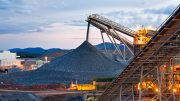As if investors weren’t gloomy enough these days. Now a survey of 100 leading companies in the mining industry suggests that executive compensation has been slow to adapt to the sector downturn, and more disturbing, that “there appears to be no relationship between return on equity and CEO pay components.”
The REM Report 2015 also found that “there was not a strong correlation between CEO pay and company financial performance,” and that the strongest correlation — “albeit modest”— was between CEO fixed pay and earnings before interest, taxes, depreciation and amortization.
The report’s authors compared base and total fees paid to chairs and non-executive directors, as well as CEOs, chief financial officers, chief operating officers, business unit heads, group counsels and corporate executives, for the year ended Dec. 31, 2014. Its findings build on the REM Report 2014, which analyzed the remuneration practices of the top-50 mining companies in the world between 2012 and 2013.
The authors are from Investec, an international specialist banking and asset management group in London; HRascent, a specialist advisory company in remuneration and compensation analysis; and Swann Global, an executive search and organizational development practice in global resources and infrastructure. Both HRascent and Swann Global are based in Melbourne, Australia.
“We are now well into the fourth straight year of underperformance of the mining sector in equity markets, and the question remains whether companies are doing enough to restructure executive pay,” Jeremy Wrathall, head of Investec’s Global Natural Resources, said in a press statement introducing the report’s findings. “It seems from this report that they are not, despite industry-wide cost-cutting.”
In terms of the survey’s methods, commodities spanned base and precious metals, coal, diamonds, industrial and energy minerals, and agricultural minerals, and data was sourced from the companies’ published reports. The mining companies also had to have a market capitalization of between US$0.5 billion and US$123 billion, and a primary listing in either the Toronto, New York, London, Australian or South African stock exchanges. The companies included global, major, mid-cap and smaller mining companies, and a few explorers with projects in development.
“The team had to write a methodology by which salary packages on six different stock exchanges can be compared, so for example, a non-cash component in London versus Toronto versus Sydney, which was quite complex,” John Revie, Swann Global’s general manager for the U.K. and Europe, explains in a telephone interview from London.
“These are the top-100 — or some of the leading 100-listed companies — around the world,” he added. “It would be interesting to see what the next 100 companies look like, or what companies ranked 800th or 1,000th might look like.”
The REM report found that for CEOs, presidents, managing directors and group managing directors the median fixed pay was US$768,000, the median fixed pay plus short-term incentives was US$1.4 million and the median total package came to US$2.2 million.
The data showed that the 20 highest-earning CEOs were paid more than $3.99 million, with U.K.-based CEOs fetching the most.
CEOs of diversified mining companies were paid more in all categories, while CEOs of specialty commodities were paid the least.
For chairs, median total fees in 2014 came to US$271,000, with a median base fee of US$158,000. (The base fee includes annual retainers, fees for chairing or being a member of a board committee, and travel and meeting attendance fees. The total fee is the base fee, plus benefits, pension and the value of equity granted for the year.)
“Mining companies have in general redoubled their efforts to cut costs from every corner of the business, except, it would appear, executive remuneration, which seems to have stayed broadly flat,” Investec said in the report.
Revie of Swann Global, however, stressed that while the findings might seem a little shocking, they should be taken with a grain of salt, since hard decisions by management teams often take several years to manifest in improved financial returns. “We need to be a little careful in drawing year-to-year correlations,” he cautioned. “But they are nonetheless numbers that people should be aware of in a world of shareholder advocacy.”





Be the first to comment on "Executive compensation proves resilient"